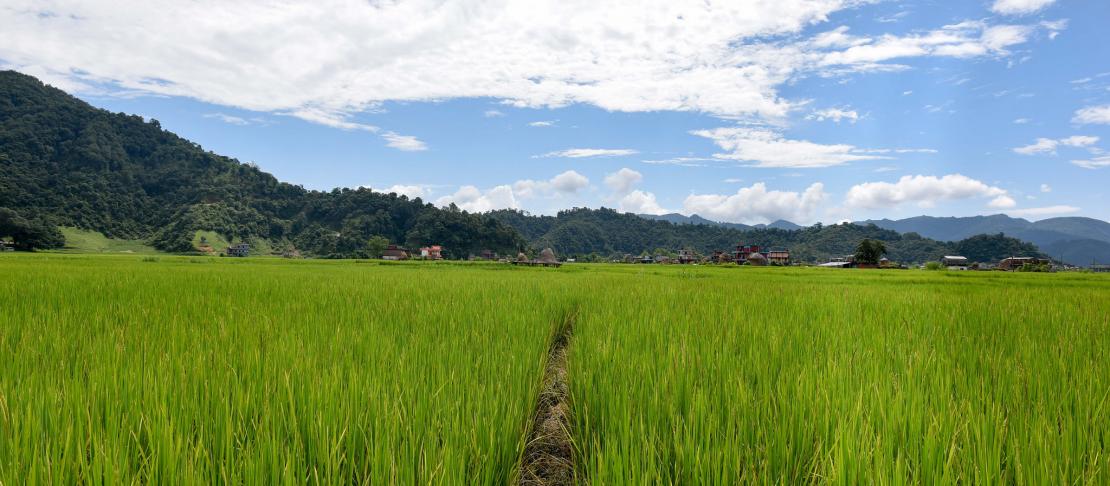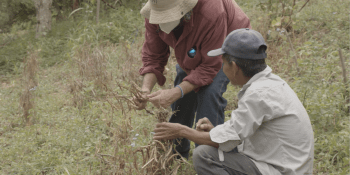Special Issue of Agriculture for Development on Climate-Smart Agriculture

CCAFS scientists share insights on the directions for climate action in agriculture
Read the special issue on climate-smart agriculture
In 2016, the editors of Agriculture for Development, the journal of the Tropical Agriculture Association (TAA), invited Bruce Campbell and Dhanush Dinesh to guest edit a special issue on climate-smart agriculture. In consultation with the Coordinating Editor of the journal, they interacted with colleagues and partners at the CGIAR Research Program on Climate Change, Agriculture and Food Security (CCAFS) to produce a broad-ranging selection of articles, news from the field, and book reviews. The special issue of the journal (Ag4Dev30) was published in May 2017. Read the special issue here.
In their guest editorial, Campbell and Dinesh explain how agriculture and food systems stand at the nexus of three of the greatest challenges of the 21st century: overcoming food insecurity, coping with the impact of climate change, and reducing greenhouse gas (GHG) emissions. For these reasons, a major movement has arisen around ‘climate-smart agriculture (CSA)’, which is focussed on the three pillars of productivity, adaptation and mitigation. The development of the CSA concept and its relationship with climate change and agricultural development is described in a new book entitled Climate change and agricultural development: improving resilience through climate smart agriculture, agroecology and conservation, edited by Udaya Sekhar Nagothu and reviewed in this special issue by Manyewu Mutamba.
In the first article, The rise in Climate-Smart Agricultural strategies, policies, partnerships and investments across the globe, Dinesh et al summarise key CSA efforts at global, regional and national levels. These include the growth in publications using the term ‘CSA’; global and regional alliances of national governments; regional and national strategies, policies and action plans; CSA concepts, programmes and projects; and investments in, and funding for, CSA. It is clear from this overview, that CSA really is one of the key ‘movements’ of our times. In CSA-Plan: strategies to put CSA into practice, Girvetz et al present guidance for operational planning and implementation of CSA. CSA-Plan frames actions into four components: situation analysis, targeting and prioritisation, programme design, and monitoring and evaluation. Putting CSA into practice requires knowing what is climate-smart in different locations and what best suits the context. There are therefore often trade-offs between the three goals of CSA: productivity, adaptation/resilience, and mitigation. CSA-Plan has already been successfully applied in many countries and with various partners.
The third pillar of CSA focuses on mitigation. This is a challenge, particularly for developing countries, where food security and adaptation are the main priorities. In many countries, fertiliser applications are below levels required for increased, sustainable production, and therefore need to increase. However, this usually leads to rises in GHG emissions. An article by Lini Wollenberg, entitled The mitigation pillar of CSA – targets and options, argues that agriculture in developing countries should be put on a low emissions development (LED) pathway. She justifies a mitigation target, for agriculture globally, of 1 gigatonne of carbon dioxide equivalent (CO2e) per year by 2030 to stay within a 2˚C emissions budget of 6-8 gigatonnes CO2e for agriculture generally. However, LED alone will not be sufficient to achieve this, so more ‘transformative actions’ will also be necessary. These include innovations such as methane inhibitors for dairy cows, and breeds of cattle and crops that reduce GHG emissions; policies such as more rigorous carbon pricing, taxes and subsidies; sequestering soil carbon; reducing deforestation; and decreasing food loss and waste.
In their article Agricultural diversification as an adaptation strategy, Noriega et al explain how agricultural biodiversity plays a key role in sustaining ecosystem services and adapting to climate change. However, the full potential of agricultural biodiversity is yet to be realised because it is context-specific, and is often dependent on appropriate enabling policies.
Loboguerrero et al highlight important contributions from outside the agricultural community in their paper Climate services and insurance: scaling CSA. Promoting CSA ‘at scale’ is a key challenge, yet climate services and insurance can provide tools to scale-up CSA by providing an enabling environment and protecting against the impact of climate extremes. In this context, climate services include the production, translation, transfer and use of climate knowledge and information to support climate-informed decision-making and climate-smart policy and planning. Index-based insurance, whereby payouts are based not on farmers’ actual losses, but on an objectively measured index that is correlated with losses, has overcome many obstacles associated with traditional crop insurance. This in turn has facilitated climate change adaptation and climate-resilient development goals.
Differentiation and inequality within communities can provide barriers that constrain women’s ability to adapt to climate change, thereby further widening the gender gap in agriculture. In their paper Closing the gender gap in agriculture under climate change, Nyasimi and Huyer demonstrate how gender-responsive climate-smart agricultural practices and technologies can provide opportunities to close the gender-gap, while at the same time adapting to climate change.
Van Etten et al argue that ‘big data’, including emerging techniques of machine-learning and citizen science, can help CSA to achieve scale and reach millions of farmers with options for tackling climate change. In their paper How can the Data Revolution contribute to climate action in smallholder agriculture? they describe and illustrate five data-related concepts linked to agricultural climate action: lean data, crowdsourcing, big data, ubiquitous computing, and information design.
A selection of Newsflashes and News from the Field articles illustrate some of the many CSA projects currently on-going around the world, including Climate-Smart Agriculture across scales in Latin America, where Loboguerrero et al highlights how policy makers of Central America and Dominican Republic are producing a regional CSA Strategy, complemented by national efforts to promote and implement CSA, for example in the Nicaraguan coffee sector. At the local level, an approach for decision making in the context of climate change was developed in Colombia, which enables farmers to make decisions using climate forecasts, this approach is now being scaled up in Colombia's Nationally Determined Contribution.
Other examples of the scaling up of CSA are the climate-smart village approach, the Adaptation for Smallholder Agriculture Programme (ASAP), and the VUNA project. Geoff Hawtin reports on climate change research in mountain areas; and Philip Thornton provides a salutary opinion piece on Climate change and CSA in the current political climate.
Finally, the TAA’s 11th Hugh Bunting Memorial Lecture, entitled Climate change and agriculture: risks and opportunities to food and farming systems in the tropics, presented by Tim Wheeler, summarises the challenge of global food production in the context of a growing population, over- and under-consumption of food, and a warming world. Impacts of climate change are presented, and some of the opportunities and responses are described.
Download the special issue: Campbell BM, Dinesh D, (Eds.). 2017. Special issue on climate-smart agriculture (CSA). Agriculture for Development no. 30.
- Girvetz E, Corner-Dolloff C, Lamanna C, Rosenstock T. 2017. ‘CSA-Plan’: strategies to put Climate-Smart Agriculture (CSA) into practice. Agriculture for Development 30:12-16.
- Wollenberg E. The mitigation pillar of Climate-Smart Agriculture (CSA): targets and options. Agriculture for Development 30:19-22.
- Dinesh D, Aggarwal P, Khatri-Chhetri A, Loboguerrero Rodriguez AM, Mungai C, Radeny M, Sebastian L, Zougmoré R. 2017. The rise in Climate-Smart Agriculture strategies, policies, partnerships and investments across the globe. Agriculture for Development 30:4-9.
- López Noriega I, Dawson IK, Vernooy R, Köhler-Rollefson I, Halewood M. 2017. Agricultural diversification as an adaptation strategy. Agriculture for Development 30:25-28.
- Loboguerrero Rodriguez AM, Hansen J, Baethgen WE, Martinez Baron D. 2017. Climate services and insurance: scaling climate-smart agriculture. Agriculture for Development 30:31-34.
- Nyasimi M, Huyer S. 2017. Closing the gender gap in agriculture under climate change. Agriculture for Development 30:37-40.
- van Etten J, Steinke J, van Wijk. 2017. How can the Data Revolution contribute to climate action in smallholder agriculture? Agriculture for Development 30:44-48.
Paul Harding is the Coordinating Editor of the Agriculture for Development journal and former Assistant Director General of Bioversity International.




